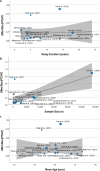Epidemiology of gall bladder cancer and its prevalence worldwide: a meta-analysis
- PMID: 40148974
- PMCID: PMC11948642
- DOI: 10.1186/s13023-025-03652-0
Epidemiology of gall bladder cancer and its prevalence worldwide: a meta-analysis
Abstract
Background: Gallbladder carcinoma (GBC) accounts for 1.3% of cancer incidence and 1.7% of cancer-related deaths which emphasizes the need for comprehensive research in epidemiological trends.
Aim: We aim to address this gap by investigating global prevalence trends across various regions, age groups, risk factors and cancer stages.
Methods: A meta-analysis of studies retrieved from Google Scholar, PubMed and Web of Science, reporting prevalence of GBC was conducted using a predetermined screening criterion. Meta Regression and Egger's Regression-based tests were employed to assess heterogeneity and publication bias, respectively.
Results: We identified three types of studies (n = 20), primarily originating from Asia (n = 10) over a cumulative time period of 24 years (1988-2012). The pooled analysis revealed a statistically significant GBC prevalence of 20.3 ± 5.2% (95% CI 9.3-31.3%, p = 0.001) among at-risk populations, including those with gallstones or cholecystitis. Analysis of potential publication bias showed none, nevertheless, individual parameters indicated varying significance. Subgroup analyses highlighted regional, temporal, and demographic variations, emphasizing the influence of factors like sample size and age on GBC prevalence. Correlation analysis demonstrated strong positive associations with sample size (p < 0.01), gender distribution (male: r = 0.85, p < 0.01, female: r = 0.806, p < 0.01), and prevalence rates (r = 0.98, p = 0.04).
Conclusion: Despite of less data present, our comprehensive overview of prevalence, regional variations, and demographic associations serves as a crucial starting point for future targeted investigations. The study fulfills a gap in epidemiology of GBC and emphasizes the need for increased attention and provides a pioneering arena in future.
Keywords: Cancer research; Epidemiology; Gallbladder cancer; Global trends; Prevalence; Risk factors.
© 2025. The Author(s).
Conflict of interest statement
Declarations. Ethics approval and consent to participate: Not applicable. Consent for publication: All authors have provided their consent for the publication of this manuscript. Competing interests: The authors declare no competing interests.
Figures




References
-
- Roa JC, García P, Kapoor VK, Maithel SK, Javle M, Koshiol J. Gallbladder cancer. Nat Rev Dis Primers. 2022;8(1):69. - PubMed
-
- Schmidt MA, Marcano-Bonilla L, Roberts LR. Gallbladder cancer: epidemiology and genetic risk associations. Chinese Clinical Oncology; Vol 8, No 4 (August 27, 2019): Chinese Clinical Oncology (Gallbladder Cancer). 2019. - PubMed
Publication types
MeSH terms
LinkOut - more resources
Full Text Sources
Medical
Miscellaneous

